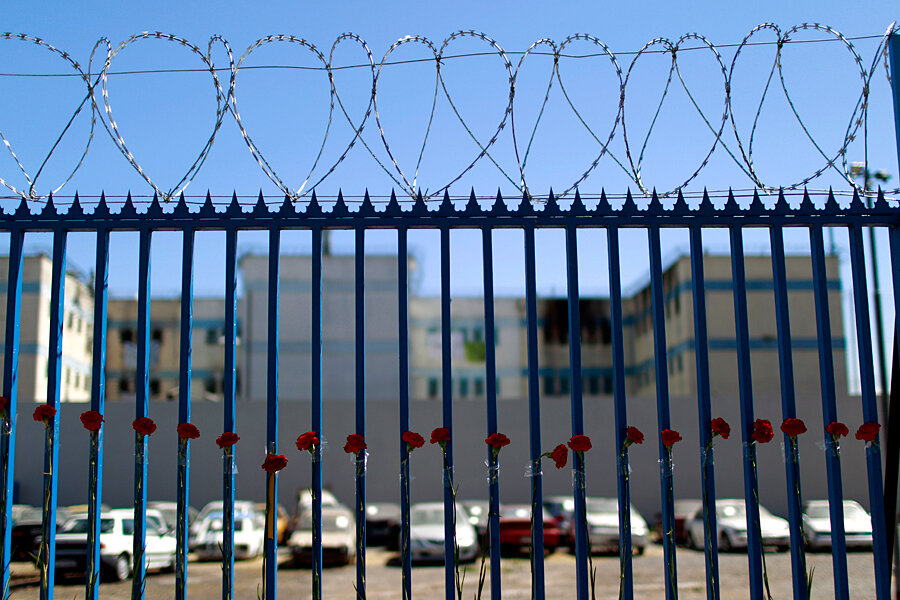Years after Chile's deadly prison blaze, conditions still under fire
Loading...
| Santiago, Chile
Images of a burnt tower at the San Miguel Prison in Santiago, Chile and of distraught relatives clamoring for news of their loved ones transfixed the nation back in 2010. The deaths of scores of prisoners in a blaze put a spotlight on the overcrowding and substandard conditions in Chile’s prisons.
At the time, family members of the 81 victims launched monthly protests, and then-President Sebastián Piñera called for changes to the “shameful” prison conditions his government had “inherited.” It seemed that change was on the horizon.
But a recent court ruling on the San Miguel Prison fire, which found no human error was to blame for the prisoner deaths, has placed prison conditions here under the microscope once again. The ruling was a reminder that despite small steps in prison reform since 2010, Chile still has a long way to go. Overcrowding is pervasive; prisoners aren’t adequately classified and separated according to the gravity of their crimes as recommended by the United Nations; and poor sanitation and abuse persist.
Many jails still have no fire-fighting equipment or staff trained to respond appropriately to emergencies, says José Maldonado, the president of the National Penal Officers’ Association of Chile, and, for the family of victims, the lack of accountability by the state raises the concern that similar tragedies could easily occur again.
“Justice has not been done,” César Pizarro, the spokesperson for victims’ relatives and the brother of a prisoner who died in the San Miguel fire, said after the April 30 verdict.
'Experts at locking people up'
The Dec. 8, 2010 blaze started after a prison brawl, and Chile’s public prosecutor alleged that guards on duty that night had been drinking before the fight. According to the prosecutor’s investigation, once the blaze began, the guards waited close to an hour before calling the fire department, and they kept prisoners trapped inside the burning building while firefighters went through security procedures to access the jail.
Despite these charges, a criminal tribunal in Santiago unanimously ruled late last month that it was the “destitute conditions” of Chile’s state-run prisons – not the guards on duty – that were to blame for the fire and ensuing deaths.
Mr. Maldonado says the court’s ruling, though unpopular, was in fact the right decision. “I can’t ask a prison guard to be responsible for worn-out infrastructure and the absence of fire-fighting equipment,” he says.
Since 2010, the government has taken small steps to address poor conditions in the nation’s 91 prisons. Through an initiative called the “Plan of 11 Measures,” the ministry of justice requires that all prisoners be provided with basic amenities like a mattress and blanket, and that prison food meet basic dietary standards.
But overcrowding is still a serious concern. “In Chile, we’re experts at locking people up,” says Maldonado. Chile has 250 prisoners per 100,000 people incarcerated, far fewer than the United States’ 707 per 100,000, but still a high rate by regional comparison.
The Chilean penal code hasn’t been revised in over 100 years, and it punishes many minor crimes with jail sentences, says José Francisco García, a lawyer at the Santiago-based Liberty and Development think tank.
“There are thousands of prisoners who are in jail for small-scale drug trafficking,” Mr. García says. One of the men killed in the San Miguel prison fire was serving a 30-day sentence for selling pirated CDs on the street.
The night of the fire, five guards and one paramedic were responsible for overseeing 1,654 prisoners in a jail built to house just under 900 people. In 2010, Chile kept 54,793 prisoners in jails designed for 34,024 people. Today there are closer to 44,000 imprisoned here, thanks in part to government pardons for some 4,000 non-violent offenders and foreign prisoners who were deported.
Ghermán Welsch, a lawyer with the Santiago-based Citizen Peace Foundation, says the 2010 fire still haunts the country, but there remains a window of opportunity for true prison reform.
“People are much more aware of the situation in Chile’s prisons after the San Miguel fire,” Welsch says. “Some people said, ‘I didn’t know what kind of conditions prisoners lived in.’ And now they’re more interested in finding out.”







